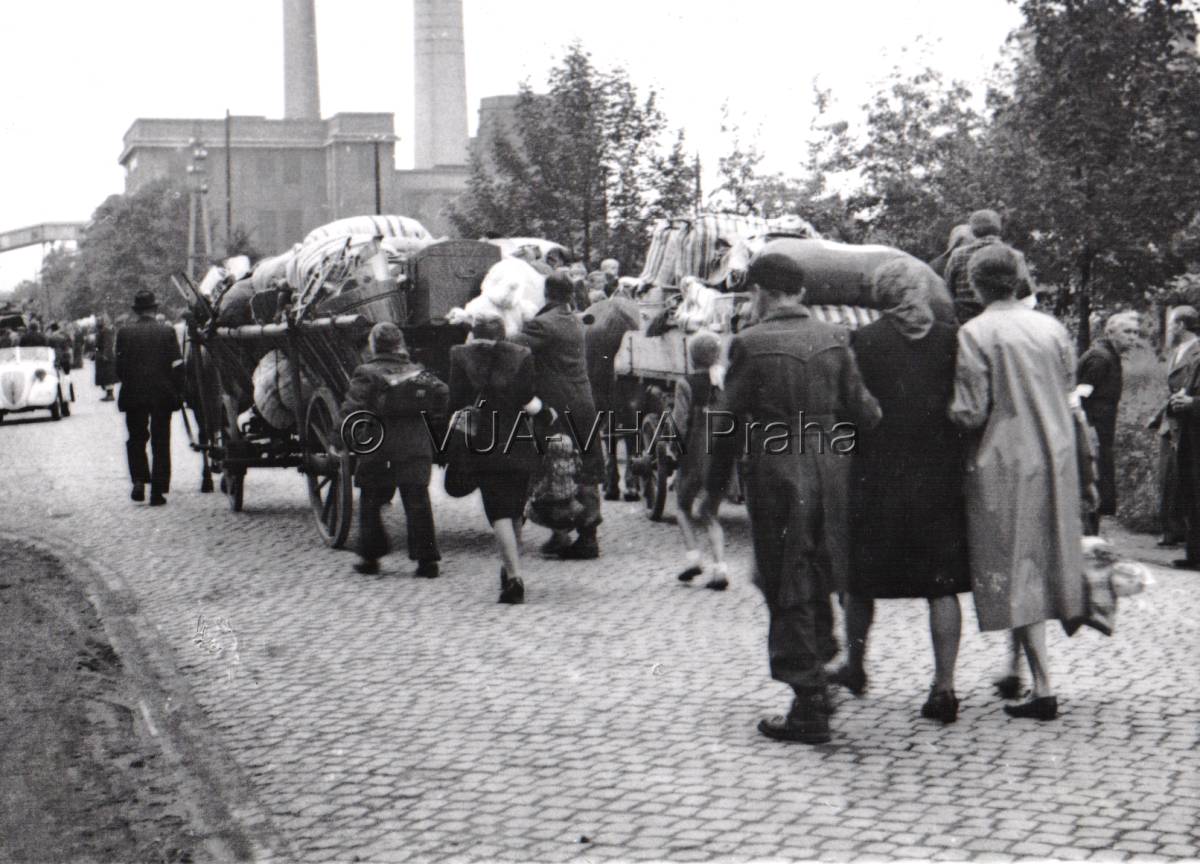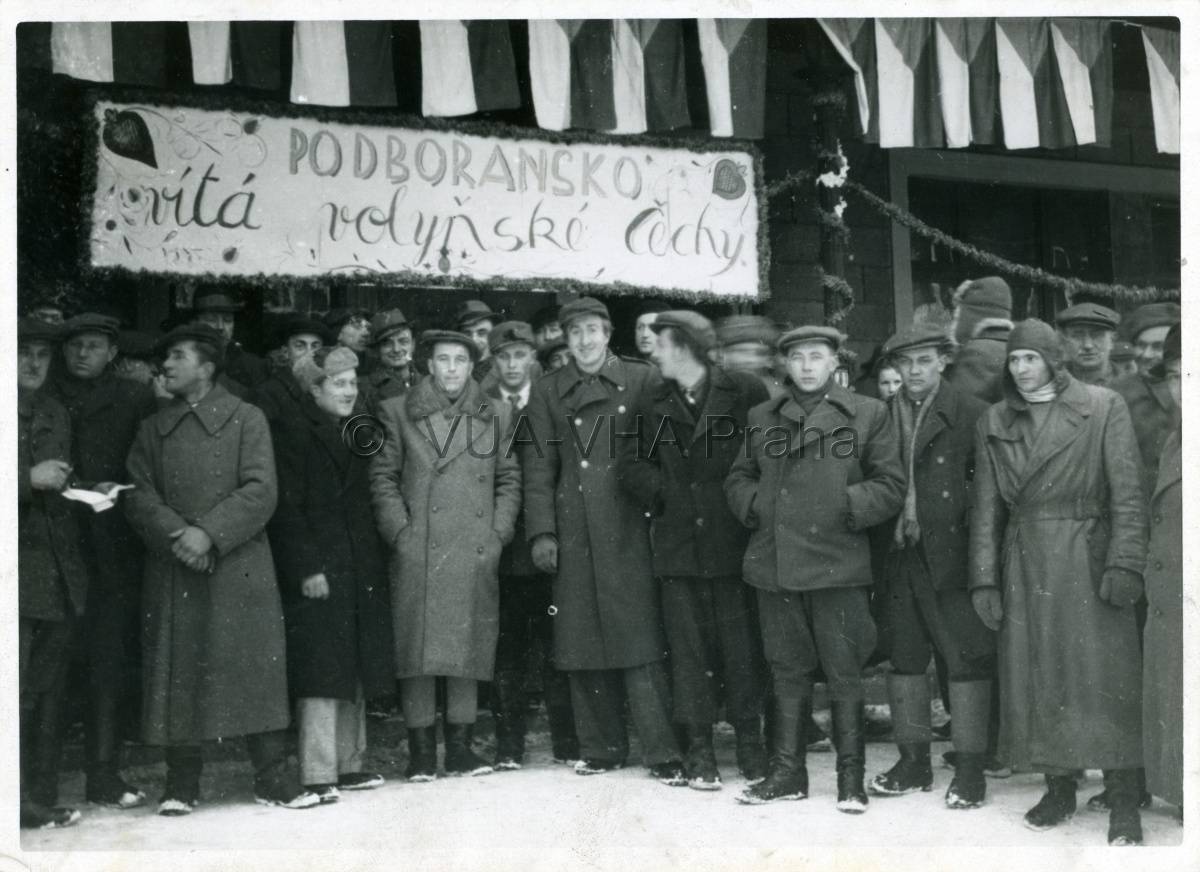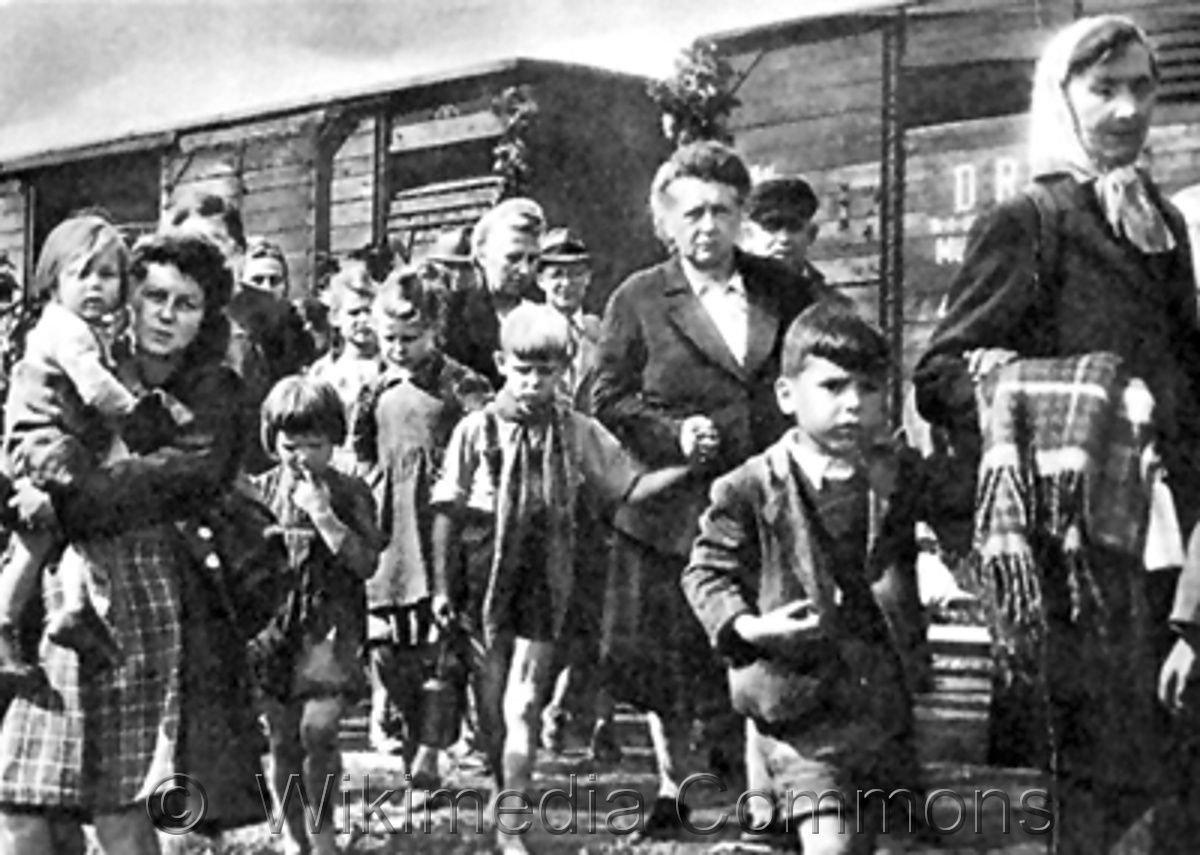Resettlement of the German population from Czechoslovakia
The efforts to deal with ethnic minorities in post-war Czechoslovakia resulted in forced mass resettlement of the German population. Initially, it proceeded spontaneously (the so-called “violent resettlement” connected with violence against the Germans), but when it was internationally agreed at the Potsdam Conference, it was organized from January until November 1946. In 1947–1948, supplementary resettlement united the torn families. In total, about 3,000,000 Germans left Czechoslovakia, the estimated number of victims is 19,000–30,000. After 1948, only anti-fascists, people from mixed marriages and the so-called indispensable experts remained in Czechoslovakia, in total about 185,000 people.

Resettlement of the Germans from Podbořany in June 1946. VÚA-VHA Praha

After the liberation of Podbořanay, those who had to leave hurriedly due to the Munich Dictate of 1938 returned to the town. At the same time, Volhynian Czechs who had fought in the 1st Czechoslovak Army Corps in the USSR for the freedom and restoration of Czechoslovakia became new citizens of the district. VÚA-VHA Praha

Czechoslovakia. Expulsion of ethnic Germans following the end of World War II. Wikipedia Commons, Sudetendeutsche Stiftung. Accesible here, [05/04/2020].
References
Staněk, T.: Internierung und Zwangsarbeit. Das Lagersystem in den böhmischen Ländern 1945–1948. München 2007;
Arburg, A. von – Staněk, T. (eds.): Vysídlení Němců a proměny českého pohraničí 1945–1951. Dokumenty z českých archivů. Díl I, II/1, II/3. Středokluky 2010–2011;
Semotanová, E. ‒ Zudová-Lešková, Z. ‒ Močičková, J. ‒ Cajthaml, J. ‒ Seemann, P. ‒ Bláha, J. D. a kol.: Český historický atlas. Kapitoly z dějin 20. století. Praha 2019.

This work is licensed under a Creative Commons BY-NC-ND 4.0
Czechoslovak exile and emigration in 1968–1989
The violent occupation of Czechoslovakia by the Warsaw Pact armies on 21 August 1968 ended a period of political ease and started a period of cleansing the society, which resulted in two decades of the so-called normalisation when 220,000 Czechoslovak citizens emigrated and defected within the third postwar wave of forced and voluntary exile. The map based on available data from 1972, 1976, 1980 and 1985 to 1988 shows departures of people from Prague, Brno and Bratislava. In 88 percent, capitalist countries were the destination.


Reception centre of the Swiss Red Cross for the refugees in the town of Buchs (the canton of St. Galen) at the end of summer 1968 where emigrants from Czechoslovakia coming from Yugoslavia were concentrated. Origin: Archives Swiss Red Cross
References
Tigrid, P.: Politická emigrace v atomovém věku. Praha 1990;
Pravdová, B.: Dějiny obyvatelstva českých zemí. Praha 1996;
Semotanová, E. – Zudová-Lešková, Z. – Janata, T. – Seemann, P. et. alli: Frontiers, Massacres and Replacement of Populations in Cartographic Representation Case Studies (15th-20th Centuries). Prague 2015;
Semotanová, E. Zudová-Lešková, Z. ‒ Močičková, J. Cajthaml, J. ‒ Seemann, P. ‒ Bláha J. D. a kol.: Český historický atlas. Kapitoly z dějin 20. století. Praha 2019.

This work is licensed under a Creative Commons BY-NC-ND 4.0
Human migration in the Czech Lands in 1961-1974
The average migration balance of the districts and district capitals between 1961 and 1974 shows that the concentration processes typical of the interwar period had already been completed in this period. The districts grew in the vicinity of the regional capitals, the Ostrava region and some of the mine districts in north-west Bohemia, which was caused by the availability of jobs in the industry. The significance of the administrative role became evident in a positive migration balance of an overwhelming majority of the district capitals except for Tachov, Karlovy Vary and Svitavy.
References
Přidalová, I. – Ouředníček, M. – Nemeškal, J.: Historické aspekty migrace v Česku. Specializovaná mapa. Přírodovědecká fakulta Univerzity Karlovy v Praze. In: Ouředníček, M. a kol.,
Atlas obyvatelstva, mapa č. 3.1. Praha 2015. On-line, dostupné z: http://www.atlasobyvatelstva.cz/ [verified 20/03/2020];
Semotanová, E. – Zudová-Lešková, Z. ‒ Močičková, J. – Cajthaml, J. ‒ Seemann, P. ‒ Bláha, J. D. a kol.: Český historický atlas. Kapitoly z dějin 20. století. Praha 2019.

This work is licensed under a Creative Commons BY-NC-ND 4.0
Human migration in the Czech Republic in 2005–2013
When monitoring migrations between the districts, their main directions and migrations of foreigners in the Czech Republic between 2005 and 2013, we notice that the main migration process was suburbanisation. It was related to the building of new residential districts and moving to districts in rural areas tied to large cities. This is particularly apparent in the Central Bohemian Region, which had a positive migration balance in all the districts because of the traffic connection to Prague and many job opportunities. This trend, however, is also connected with decreasing the size of most of the district capitals. In general, the migration intensity dropped, thus partially stopping the depopulation of the rural areas.
References
Přidalová, I. – Ouředníček, M. – Nemeškal, J.: Historické aspekty migrace v Česku. Specializovaná mapa. Přírodovědecká fakulta Univerzity Karlovy v Praze. In: Ouředníček, M. a kol.,
Atlas obyvatelstva, mapa č. 3.1. Praha 2015. Accesible at http://www.atlasobyvatelstva.cz/ [20/03/2020];
Ouředníček, M. – Přidalová, I. – Nemeškal, J.: Migrace v Česku 2000–2013. Specializovaná mapa. Přírodovědecká fakulta Univerzity Karlovy v Praze. In: Ouředníček, M. a kol.,
Atlas obyvatelstva, mapa č. 3.2. Praha 2015. Accesible at http://www.atlasobyvatelstva.cz/ [verified 20/03/2020];
Semotanová, E. – Zudová-Lešková, Z. ‒ Močičková, J. – Cajthaml, J. ‒ Seemann, P. ‒ Bláha, J. D. a kol.: Český historický atlas. Kapitoly z dějin 20. století. Praha 2019.

This work is licensed under a Creative Commons BY-NC-ND 4.0

